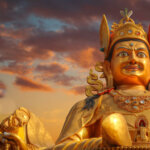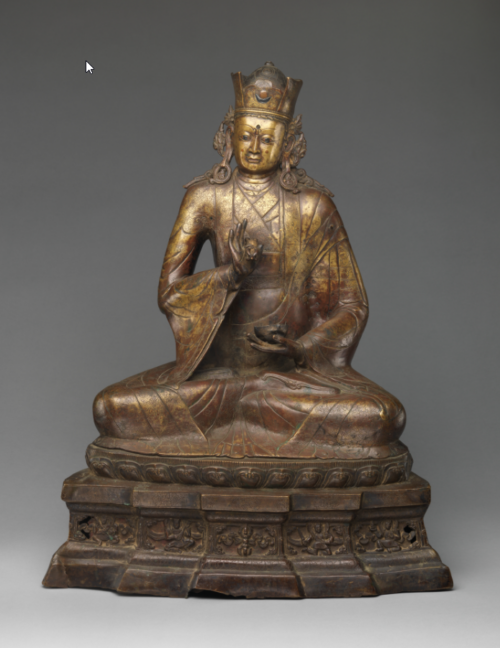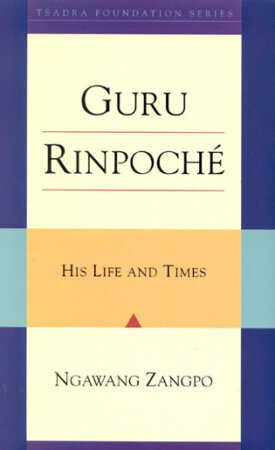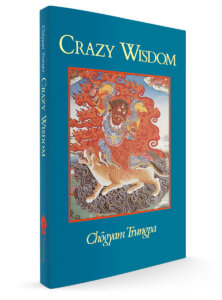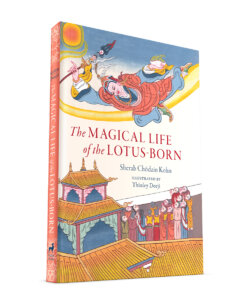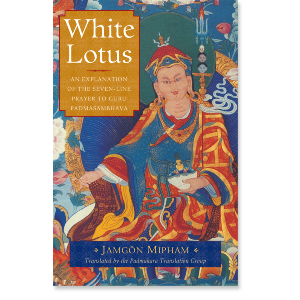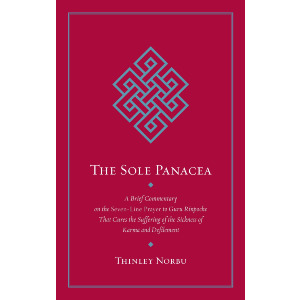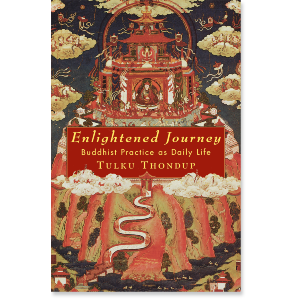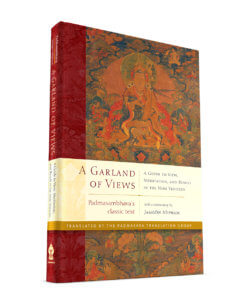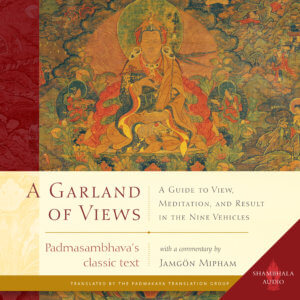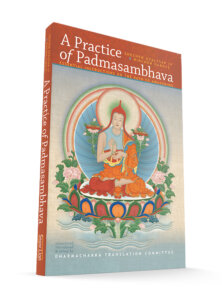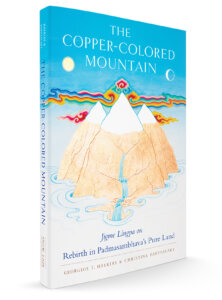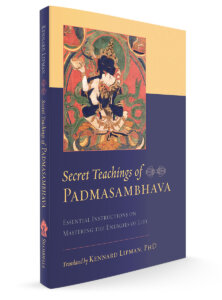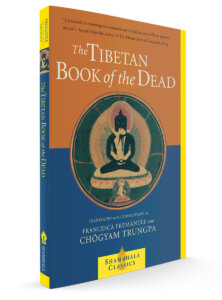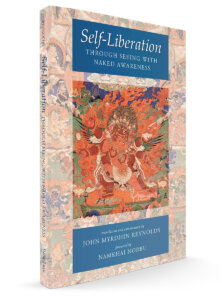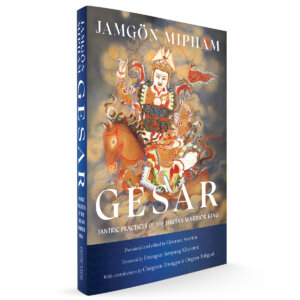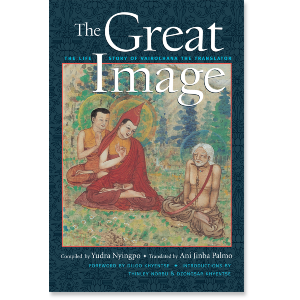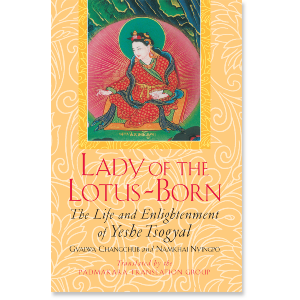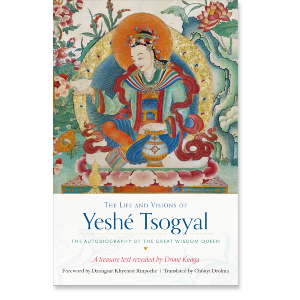Some Nyingma Lineages: Dudjom Tersar | Longchen Nyingtig | Namcho & Palyul
Guides to Other Important Nyingma Figures:
Rongzompa | Longchenpa | Jigme Lingpa | Patrul Rinpoche |
Sera Khandro | Mipham Rinpoche | Dilgo Khyentse | Dudjom Rinpoche
We begin this Reader’s Guide to Guru Rinpoche, also known as Padmasambhava, with some trepidation, as it is a delicate task to try and write a short article on a figure so central to the Tibetan Buddhist tradition and so revered by many, whose life and legacy are so rich. The attempt feels deficient, yet there are some great resources for practitioners that are important to highlight. Also, so many termas, or rediscovered treasures are in fact from Guru Rinpoche, that excluding them feels a bit odd but to include them would be overwhelming. In fact, there are few books in the Nyingma tradition where Guru Rinpoche is not a central figure.
This guide presumes readers already have a basic understanding of Guru Rinpoche, and how he is an historical figure and saint, considered a Buddha as well a focus of meditation in the form of the Guru, and the source of an incredible corpus of teachings.
Biographical Accounts
Hardcover | Ebook
$28.95 - Hardcover
Guru Rinpoche: His Life and Times
Introduced and translated by Ngawang Zangpo
The first half of the book includes six chapters where Ngawang Zangpo lays out an important framework for understanding Guru Rinpoche's impact and the mileiu he entered on his arrival to Tibet. These include:
- Buddhism, History, and the Truth
- Buddhist History after the Buddha
- Tibet and Asia on the Eve of Guru Rinpoché’s Arrival
- India in Guru Rinpoché’s Era
- Guru Rinpoché Now—in Print
- Timeless Guru Rinpoché and Wisdom Bridges to the Present
There are many account of Guru Rinpoche's life, and the second half of the book is collection of vitally important accounts about his life is an invaluable resource.
- A Biography of Guru Rinpoche by Jamgon Kongtrul
- The Immaculate White Lotus by Dorje Tso
- The Indian Version of the Life of Guru Rinpoche by Taranata
- The Bön Version of the Life of Guru Rinpoche by Jamyong Kyentse Wongpo
- Supplications to Guru Rinpoche in Seven Chapters by Guru Rinpoche
- Visualizations to Accompany the Supplications by Jamgon Kongtrul
Paperback | Ebook
$21.95 - Paperback
Crazy Wisdom
This fascinating book examines the life of Padmasambhava to illustrate the principle of "crazy wisdom". From this profound point of view, spiritual practice does not provide comfortable answers to pain or confusion. On the contrary, painful emotions can be appreciated as a challenging opportunity for new discovery. In particular, the author discusses meditation as a practical way to uncover one's own innate wisdom.
He uses the model of the Eight Names (or aspects of manifestations) of Guru Rinpoche, and goes through each in detail.
Trungpa Rinpoche makes a strong case that those in the west need Padmasabhava as badly as the savage and uncultured Tibetans of the eighth century.
Hardbound | Ebook
$21.95 - Hardcover
The Magical Life of the Lotus-Born
By Sherab Chodzin Kohn, illustrated by Thinley Dorji
Explore a fresh telling of the inspiring, mysterious, and magical life of the great master Padmasambhava—the Lotus-Born—who planted the seed of Buddhism in Tibet that is still blossoming today, beautifully illustrated for ages 10+.
Here, his magical life story is outlined in colorful and captivating detail, offering young readers a rare glimpse into his fierce adventures and battles that transformed Tibet, a land of malevolent spirits and wild folk, into a fertile ground for Buddhism. The rich and vibrant spiritual tradition that resulted in Tibet has thrived for over one thousand years. This timeless tale is sure to capture the imagination of future generations, just as the oral, theatrical, and written accounts of it have in the Himalayas for centuries.
The Seven Line Prayer
The Seven-Line prayer to Guru Rinpoche is one of the most ubiquitous and important prayers, performed across lineages and in particular the Nyingma tradition who commence nearly every practice with it and for which there are dedicated sadhanas based on it. Below are several of the books about it.
Visit our page dedicated to resources about the famed Seven Line Prayer
$18.95 - Paperback
$19.95 - Paperback
$23.95 - Paperback
Works and Practices Related to Padmasambhava
Hardcover | Ebook
$22.95 - Hardcover
A Garland of Views: A Guide to View, Meditation, and Result in the Nine Vehicles
by Padmasambhava and Mipham Rinpoche
A Garland of Views presents both a concise commentary by the eighth-century Indian Buddhist master Padmasambhava on a chapter from the Guhyagarbha Tantra on the different Buddhist and non-Buddhist philosophical views, including the Great Perfection (Dzogchen), and an explicative commentary on Padmasambhava’s text by the nineteenth-century scholar Jamgön Mipham (1846–1912).
Padmasambhava’s text is a core text of the Nyingma tradition because it provides the basis for the system of nine vehicles (three sutra vehicles and six tantra vehicles) that subsequently became the accepted way of classifying the different Buddhist paths in the Nyingma tradition.
Padmakara Translation Group translator Stephen Gethin on Garland of Views
Paperback | Ebook
$21.95 - Paperback
A Practice of Padmasambhava: Essential Instructions on the Path to Awakening
A Practice of Padmasambhava presents two practical and compelling works related to a visualization and mantra practice of Padmasambhava. This practice is based on the most important revelation of the renowned nineteenth-century treasure revealer Chokgyur Lingpa, Accomplishing the Guru's Mind: Dispeller of All Obstacles. These two works give an introduction to the preliminary trainings, outline the primary elements of visualization practice and mantra recitation, and supply a detailed explanation of the practice of Padmasambhava's wisdom aspect, Guru Vadisimha. Through practical step-by-step instructions on this deity, the reader is guided into the general world of tantric practice common to all of Tibetan Buddhism.
Paperback | Ebook
$29.95 - Paperback
The Copper-Colored Mountain: Jigme Lingpa on Rebirth in Padmasambhava’s Pure Land
By Jigme Lingpa, George Halkias, and Christina Partsalaki
The Copper-Colored Mountain is the pure land of Padmasambhava, the Indian master who brought Buddhism to Tibet. One way in which Buddhist practitioners may be reborn in this pure land is by making aspiration prayers. This work includes a translation of one of the most famous of these aspiration prayers, composed by Jigme Lingpa, and the authors’ verse-by-verse analysis of it. Drawing on both traditional commentaries and contemporary scholarly texts, the authors show how Jigme Lingpa encodes many features of Tibetan Buddhist tantric practice in these verses, and thus they provide a feast of meaning for tantric practitioners.
Paperback | Ebook
$18.95 - Paperback
Secret Teachings of Padmasambhava: Essential Instructions on Mastering the Energies of Life
By Padmasambhava, translated by Kennard Lipman
Translations of several short but important texts on Innermost Essence of the Dakini (Khadro Nyingtig).
These two teachings of Padmasambhava, The Fivefold Essential Instruction and A Section of Hidden Instruction, the Innermost Essence of the Dakini, are certainly of interest to the serious practitioner of the Vajrayana. They not only present well-known tantric teachings of channels (tsa), energy (lung), and potencies (tigle) in a clear and practical way, but they also offer us a unique Dzogchen perspective on them. In addition, they give us a glimpse into life on retreat with two of the greatest masters of Tibetan Buddhism, Padmasambhava and Yeshe Tsogyal.
Paperback | Ebook
$16.95 - Paperback
The Tibetan Book of the Dead: The Great Liberation through Hearing in the Bardo
By Padmasambhava, Karma Lingpa. Translated and introduced by Chögyam Trungpa and Francesca Freemantle
Written by Guru Rinpoche, rediscovered as a terma by Karma Lingpa, and translated and introduced by Chögyam Trungpa and Francesca Freemantle, this work is traditionally read aloud to the dying to help them attain liberation—death and rebirth are seen as a process that provides an opportunity to recognize the true nature of mind. This translation of The Tibetan Book of the Dead emphasizes the practical advice that the book offers to the living. The insightful commentary by Chögyam Trungpa, written in clear, concise language, explains what the text teaches us about human psychology.
Paperback | Ebook
$24.95 - Paperback
Self-Liberation through Seeing with Naked Awareness
By Padmasambhava, Karma Lingpa, and John Myrdhin Reynolds
Teaching the attainment of Buddhahood in a single lifetime, this text was written and concealed by Guru Padmasambhava in the eighth century and rediscovered six centuries later by Karma Lingpa. The commentary by the translator is based on the oral teachings of Namkhai Norbu Rinpoche and Lama Tharchin Rinpoche.
Paperback | Ebook
$29.95 - Paperback
Gesar: Tantric Practices of the Tibetan Warrior King
By Mipham Rinpoche, Orgyen Tobgyal Rinpoche, Chogyam Trungpa. Introduced and translated by Gyurme Avertin
The King, protector, and deity Gesar of Ling is intimately connected with Guru Rinpoche. In his Garland of Jewels, Mipham Rinpoche explains that "The lords of the three families are Manjushri, Avalokiteshvara, and Vajrapani; their magical manifestation is Guru Rinpoche; and his emanation is Gesar Norbu Dradul. As Gesar prayers often specify, the 'emanation of Padma and the three families, Great Lion Gesar." This work explains the connection in several sections.
Orgyen Tobgyal relates:
Basically, the deity Gesar doesn’t exist; he is simply Guru Rinpoche in the form of a drala—a form he takes to help raise the windhorse of sentient beings. Guru Rinpoche is also the embodiment of the enlightened qualities of all the buddhas. His enlightened activities are unfathomable, but a small fraction took place in the Land of Ling, 'the awe-inspiring Ma valley' in Kham—this is what it’s called in all the stories written about Gesar.
Books on Some of Guru Rinpoche's Contemporaries
We also encourage readers to explore the excellent series of books on Padmasambhava, Following in Your Footsteps, published by Rangjung Yeshe Publications.
Additional Resources


